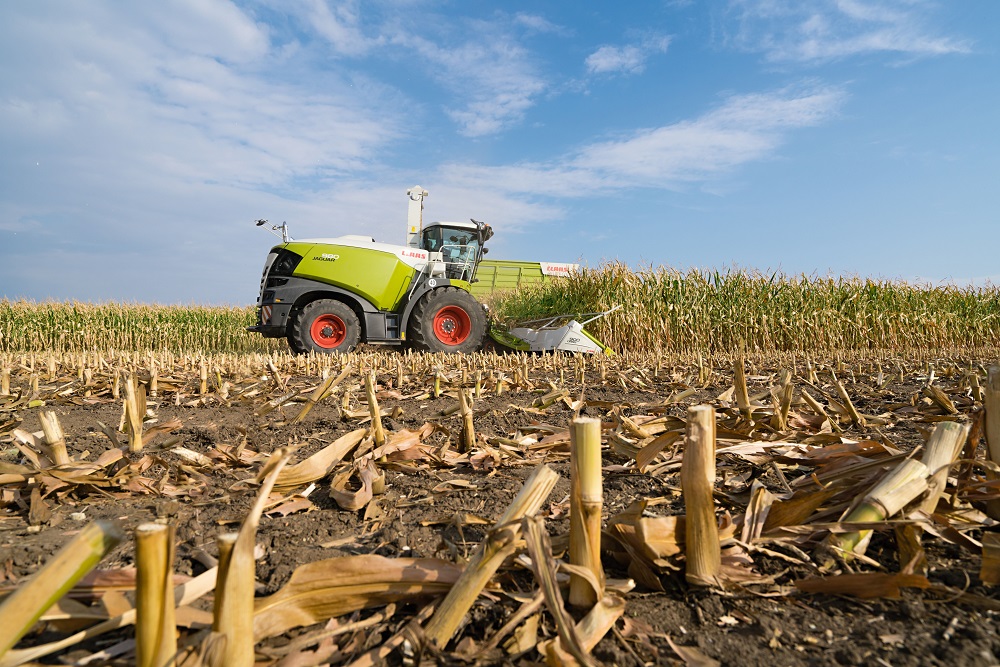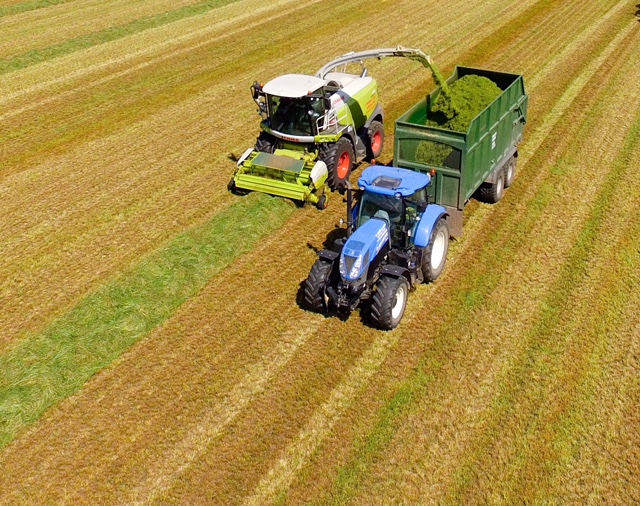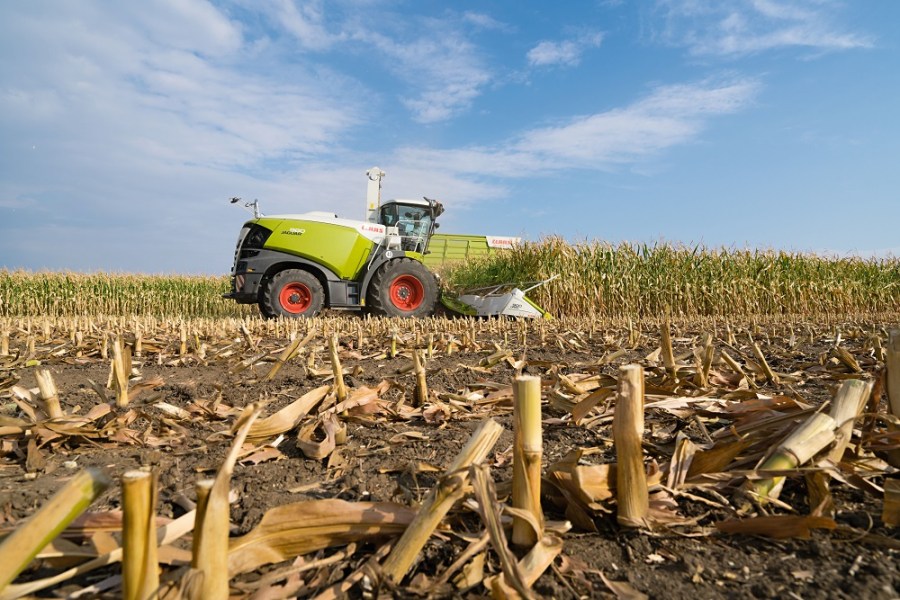
Amid growing demand for anaerobic digester feedstock, many arable farmers are using contractors with high output forage harvesters to bring in the crop. CPM takes a look at custom AD-harvesting UK style.
My primary objective is to sell my customers machinery and contract services and there’s a lot of preparation work that needs to be done beforehand to make a job run smoothly.
By Jane Brooks
Tim Russon of P Russon and Sons, has almost 30 years’ experience of agricultural contracting. His arable and grassland operation offers clients wide-ranging services from crop establishment through to harvest, as well as precision chopping to the specifications required for bio-digester feedstock.
On the foraging side of the business he runs a pair of Claas Jaguar 970 foragers cutting 5000ha of silage annually, three quarters of which is maize for digester feedstock and some rye grass for biomass.
An additional Jaguar 870 with a Kemper 360 plus header harvests miscanthus grass for biomass, which goes into power stations. “We’re cutting almost countrywide, harvesting about 1200ha of miscanthas per annum. It’s a specialist crop which is expensive to establish with no income for two or three years,” he explains.

Tim Russon has harvested AD feedstock for about six years, running three Claas foragers, alongside 14 Bailey silage trailers.
“I also find ryegrass being used as a break crop and cultural method to assist in the control of blackgrass, as well as presenting an opportunity to get digestate out of the plant and use it in a sustainable way.”
He has 14 full time employees and can employ an additional 16 seasonal staff making up to 30 or so in total, as well as a covering a wide geographical spread of clients, so managing the teams and their workload is a full time task for Tim Russon.
“The three forage gangs run to around 30 men, and my job is managing what they’re doing and progressing into the next job. You’re always thinking a few days ahead because in good maize harvesting conditions we’re clearing the best part of 100-120ha/day.
“I also work closely with Andy Holmes of TR Holmes to share extra labour and tractors and trailers at peak times,” he adds.
The business also bales a lot of silage and straw in various shapes and sizes – conventional, bandit, round and Heston-type bales. What’s more, it has a site baling waste at Grimsby, producing 60,000t of solid recovered fuel (SRF) for a Dutch company exporting to Latvia.
“After leaving college in 1988, I started with a small forage harvester purchased from Mill Engineers, just as maize gained popularity. My father, who was a dairy farmer had grown it for cattle since the mid 1970s, so I was already established as the AD market emerged,” recalls Tim Russon.
“We’ve harvested AD feedstock for about six years, running three Claas foragers, alongside 14 Bailey silage trailers. Claas have always supplied our foragers and last June we traded an older Jaguar 970 for a pre-production 498 series Jaguar 970, with some new 2017 season upgrades.”
Tim Russon offers planting and harvesting but not digestate spreading. Ground preparation tends to be for livestock farmers, whereas AD plants are usually associated with large arable farmers, who often cultivate and drill themselves.
“We’ve four Kverneland eight-row precision maize drills with placement fertiliser. We like to use diammonium phosphate (DAP) or monoammonium phosphate (MAP) with a view to trying to place that 50mm to the side and a little bit deeper than the seed.
“We have applied micro granular fertiliser for some clients when drilling maize, instead of using DAP placement, however generally our customers don’t seem to have noticed any benefit from micro granular fertiliser and prefer to stick to applying DAP themselves.”
Spraying is carried out with a Chafer Rogator 418. “Chafer is a local company and we’ve used their sprayers for many years. In addition to crop protection products we apply liquid fertiliser with the Chafer or spin on granular fertiliser with a KRM Bredal.
“Variable applications are based on mapping provided by our clients – they generally provide a memory stick and away we go. Jobs run more smoothly when there’s a prescription ready to go, so its important farmers’ maps are up to date. I also leave seed and crop protection decisions to the farmer, his seed agent and agronomist.”
The business runs New Holland tractors and Fastracs, fitted with Trimble RTK, and subscribes to Soil Essentials who provide the signal. “Wherever we are, we get good coverage – it’s quite expensive but necessary,” he adds. The combine is a Claas Lexion 670, and as well as combining traditional crops there’s a maize header. The foragers have a Cebis control system as well as autosteer.
Tim Russon also farms 120ha, of which 80ha is cropped with winter wheat, winter barley, oilseed rape and maize. The remainder is grassland, which feeds 25 suckler cows.
“The agronomist on my own farm is James Pickwell of Frontier, but I pay him to walk the fields independently and source the chemical. He’s one of my clients, with a small farm of his own.”
Locally there’s a huge blackgrass burden, notes Tim Russon, but this depends on the farm. “About 5% of my own farm has blackgrass, but by rotating grass and maize as well as rogueing we’ve managing to contain it. This year I suspect there’ll be less, as with the dry spring I don’t think much has germinated.
“We took delivery of the pre-production Type 498 Claas Jaguar 970 forage harvester in June 2016. We specified an Orbis 12-row maize header and in common with the other Jaguar 970 it has a 40km/h box.”
The engine remains the 16.2-litre MAN V8 rated at 775hp. Claas uses a Dynamic Power automatic engine control system, which regulates engine power depending on speed. Because the engine is over 760hp, emissions regulations don’t apply so there’s no requirement for Adblue.
Both Jaguar 970s have the Cruise Pilot automatic speed control system, which may be familiar to Lexion combine operators. To use cruise control the driver programs a target engine speed into the Cebis terminal. It’s then activated using a push button on the multifunction lever.
The Jaguar maintains the specified engine speed, making adjustments to allow for crop density changes. The system operates by detecting the throughput volume and engine-operating speed. The driver can choose between the three operating modes – cruise control (constant vehicle speed), output (constant throughput) and maximum engine-operating speed.
The optional CMotion multifunction lever was first available on the Xerion tractor in 2009 and can control up to 13 machine functions. Four-wheel drive is standard, as are metal and stone detectors.
Upgraded 2017 features include an optional continuously variable front-attachment drive designed to enable header and feed rollers to work more easily together, by varying the front attachment speed to match that of the feed rollers. It’s available for the Orbis maize header and pick-up.
In addition to shear-bar improvements, the sharpening system’s had improvements to access for maintenance, alongside better guidance of the sharpening stone to ensure the chopping cylinder blades stay in optimum condition.
The new models also work with an automatically adjusted chopping-cylinder concave. It’s attached directly to the shear-bar mounting system and is automatically moved with the shear bar when it’s adjusted.
This means the distance between the concave and the chopper cylinder remains constant as the chopping-cylinder blades wear, which Claas says ensures an even crop flow, regardless of the condition of the blades.
“We need a short and consistent chop for AD plants, the new model presents the crop to the chopping cylinder better giving a more consistent chop,” explains Tim Russon.
“My driver Jonny Beatie, initially didn’t like the new forager, but when a few teething problems were resolved he got on well with the bigger header and wouldn’t go back to the old one.”
The upgraded running gear features a new hydrostatic double motor, a variable hydraulic motor which has a wide speed range, allowing the Jaguar to travel at 40km/h at only 1300rpm, enabling road use at very low engine revs, which Claas says has a positive effect on diesel consumption.
Auto-fill now also allows auto loading to the rear using a new high-resolution camera on the discharge spout that continuously scans the trailer, automatically adjusting the crop discharge direction relative to trailer position and load size. However, although he does have a rear camera fitted, Tim Russon’s pre-production model doesn’t have the auto-fill option.
Another new option is automatic limited slip differential lock, which Claas says enables optimal traction, even under difficult conditions. When fitted it can be controlled either manually, in automatic switch-on mode, which is triggered when wheel slip is detected, or in automatic switch-off mode when a given steering angle and speeds greater than 15km/h are reached.
“The new forager has done about half a season as we didn’t take delivery until June. Residual value is a concern – it’s a huge investment and I can see the depreciation on these large machines being considerably more pro rata than on the smaller machines as there’s less of a used market for them.
“I usually keep them for four years, but suspect we’ll extend that. It comes with a standard one-year warranty, and I don’t have the option to extend it. However, we have that option on tractors and extended the warranties for five years.”
He finds the new 498 series Jaguar 970 is around 10% more fuel efficient that the old one, which equates with what Claas claims for it. “I don’t know if that’s all attributable to the new designs on the machine because the old machine has a ten-row maize header whereas the new one has 12 rows.
“We like the wider header, the next one we buy will be a 12-row as well, which is the widest header they make,” he adds.
The new machine handles well on the road, too. “One feature we like on both the Jaguar 970s is the auto tyre-inflation system. We can reduce tyre pressure in the field and re-inflate for roadwork. I think we’re getting better tyre wear running the tyres at the correct inflation as opposed to a one size fits all approach.
“Early on we had a faulty sensor on the drum that wasn’t reading correctly, affecting crop feeding and drum-input speed, but it was soon rectified and it’s fantastic now.”
With high work rates and tight harvest windows, minimising downtime is crucial, so good dealer back up is essential. Tim Russon has nothing but praise for the aftersales service from Claas UK and his local dealers Claas Eastern.
“I’m happy with how they dealt with the sensor issue, it was a new machine, there were only two like it in the country so it’s a learning curve. It went well in the maize with a tremendous output – there were three days when the team cut over 60ha of maize each day with that one machine.”
Getting the job done
Knowledge, experience and the ability to undertake work in a timely manner, are all part of the mix when it comes to finding the right agricultural contractor. Experts advise that having the appropriate insurance and well maintained equipment as well as agreeing rates before commencing work are also important, as is arranging payment terms.
Tim Russon is a member of the National Association of Agricultural Contractors (NAAC), which represents contractors in the UK who supply all types of land-based services to farmers, government, local authorities, sports and recreational facilities.
He’s also a member of the NAAC Assured Land-Based Contractor Scheme (ALBC), which is designed to provide a review of the business and help contractors improve their record keeping.
To find a competent contractor, NAAC advice is to:
- Check your contractor has the necessary qualifications and training (e.g. NRoSO membership if spraying, application qualifications, etc).
- Ensure the contractor receives full information about your land, including footpaths, watercourse and environmental risk areas, bio-security requirements, farm assurance schemes and what action may be required.
- Warn your contractor of safety issues, such as overhead power lines, hidden obstacles, dangerous terrain.
- Agree on responsibility for supplying/purchasing inputs (spray, seed, fertiliser) and if necessary keep good communication links open between yourself, the agronomist and contractor.
- Designate who is disposing of all empty packaging and where washing and filling will take place if spraying.
Farm facts
P Russon and Sons, New Farm, Burton, Lincoln
- Cropping: 120ha on farm wheat, barley, OSR, maize. 5000ha plus contracting
- Soils: Blow-away sand to heavy clay
- Mainline Tractors: 4x New Holland T7235, 2x T7200, T7030, TM190, 6070, TSA135, 3x 7120; JCB 2155 Fastrac; Massey Ferguson 135
- Foragers: 2x Claas Jaguar 970, Jaguar 870
- GPS: Trimble RTK Soil Essentials
- Combine: Claas 670 combine; Claas Maxi Swather
- Loaders: JCB 435, 434, 416
- Telehandlers: JCB TM310, JCB530-70
- Drill: Kverneland Maize drill x 4
- Cultivation: Kuhn 4m power harrow
- Plough: Lemkin 4f
- Sprayer: Chafer 418 Rogator
- Spreader: KRM Bredal
- Staff: 14 full time employees, plus up to 16 seasonal workers.




